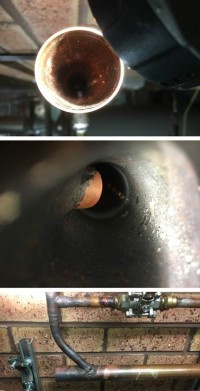Contributed by Richie Paddick
Richie Paddick has 42 years’ industry experience and is the Licensed Plumbing Contractor at Osborne Park Hospital. He worked for many years as a plumbing contractor in remote communities and mine sites, where he developed a strong interest in the areas of water quality management and Legionella management and recognised the business opportunities they create for plumbers. Richie has written and administered a Legionella Management Plan for a Rio Tinto mine site and co-written a Water Quality Management Plan and Facility Safety Water Plan for Sir Charles Gairdner Hospital.
Historically, plumbers were taught particular hand skills. Over time, the demands on our industry and an increasing reliance on technology have allowed plumbers to speed up and punch out more work in a day than we once might have. Press-fit copper fittings are an important example of this change.
Whilst these advances improve productivity, they have deskilled our trade. There are times when our forgotten hand skills should be employed, to not only enhance the appearance of our pipework, but more importantly, to minimise the long-term detrimental effects of poor workmanship on water quality.
From a water quality perspective, we need to think about the water from the inside of the water pipe. We need to ensure the internal bore is as smooth as possible, eliminating areas where the accumulation of particles can enable biofilm to grow. We also need to help the water flow in the intended direction by using sweeping connections where possible, particularly on hot water (and warm water) flow and return loops. Protrusions into water pipes, once considered unacceptable, are now becoming increasingly common. This is likely due to the demand for productivity over quality.
Over the past 20 years, I have had conversations with plumbers who were engaged to replace water supply work on copper tube of all sizes up to 150 mm. I would mention that all tee pieces should be fabricated saddle joints. Invariably I would find the joints, although very well fabricated, were not saddle joints but junctions. Upon talking with the plumbers, I found they were never taught the difference. After hearing the explanation and being shown how to fabricate these joints, the men all agreed they were superior and could understand their purpose, which is to ensure there was no intrusion into the main pipe.
The following photographs demonstrate typical installations that have the potential to cause contamination of the water supply due to internal surface obstructions, which can harbor bacteria and cause a high HCC reading.
Incorrectly fabricated tee piece. The branch pipe is inserted into the main pipe.
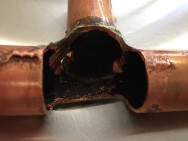
Intrusion into main pipe from incorrectly fabricated tee.
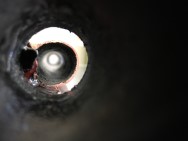
Correctly fabricated 'saddle joint' tee piece. The branch pipe fits over main pipe and cannot enter the main pipe.
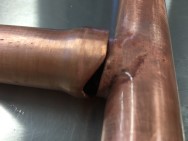
Internal picture of main pipe, no intrusion at new joint. In the background is the intrusion from incorrect joint.
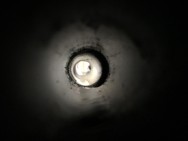
Typical (incorrect) fabrication method of reducing pipe size and terminating a branch.

Internal view of the above, showing potential HCC growth areas.
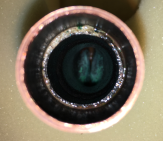
Intrusion into hot water return loop.
